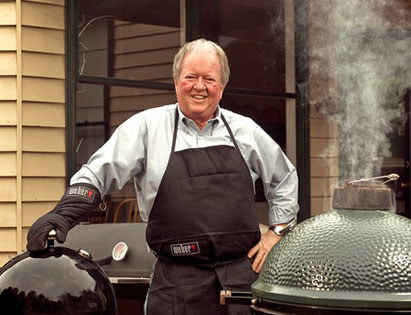Bob Hart’s Beef Ribs on the Grill

BOB HART’S GRILLED AND BRAISED BEEF RIBS
It’s probably the joyous vulgarity of chomping into a meaty bone like a ravenous caveman but … I am addicted to beef ribs of all shapes and sizes. I am often asked if these sturdy, meaty wonders can be cooked decently on a gas barbecue. And my answer had been, until I finally devoted some serious cooking time to wrestling with the issue, probably not. Silly me.
Because provided you are prepared to do a bit more than conventional grilling and roasting, you can cook them magnificently on a grill. A spot of braising, clearly, is required to deliver the sort of tender and tasty ribs that dreams are made of, but so what?
Never be afraid to braise on a barbecue, whether it is a gas grill or, as I discovered during my experimentation, a kamado: I used a Saffire grill with, initially, a Big Green Egg cast iron grill and, for the braising period, a heat deflector over the same, fierce fire. The advantage of the kamado, of course, is that it allows you to add a hit of hickory to the flavour of your ribs. Mind you, the results I have achieved on a Weber Genesis, and the simplicity of the braising sequence on a gas grill of that quality, is also miraculous. And surprising. Try this:
Pick up 2kg of beef ribs – short ribs, perhaps, or a couple of those stonking great whole ribs, each knocked into three. Any serious butcher will have or will obtain these for you and, if not, change butchers. Do not expect to find them in a supermarket which, in my view, is no place from which to source serious meat, anyway.
Sprinkle the ribs generously with sea salt and my multi-purpose dry rub, place them in a large resealable plastic bag and refrigerate overnight, or longer if you choose.
Now, fire up a gas grill or a kamado and prepare some braising liquid in a grill-friendly baking dish or, my preference, a large Le Creuset pan by combining two small bottles of wheat beer, 1 1/2 cups of water, 2 tbs raw sugar, two flattened (but unpeeled) garlic cloves and several sprigs of fresh thyme.
Lightly oil (with EV olive oil) the ribs and return them to room temperature. Also, slice three red onions into thick (1.5cm) rounds, spike each ring with a metal skewer to hold the rings together, oil and season. Clean and lightly oil the grill which should be at least 220C, or even a touch higher. Place the ribs and the onions on it. Cook them, moving them through 90 degrees after three minutes on the first side, and cook for a total of six minutes a side – covered, of course. Remove the onions and add to the braising liquid at this stage and continue to sear the ribs until they are comprehensively charred. Depending on the power of your grill, you may need to reduce the heat slightly while doing this, but keep the temperature fairly. A touch above will not hurt. But actual cremation, as in life, should be avoided.
Now lift the grill-marked, caramelised ribs off the grill and place in the pan with the braising liquid. Cover with foil or a lid and place on the grill, reducing all burners to low and turning off the burner under the pan completely once a temperature of around 160 C has been reached in the barbecue. Or, alternatively, by placing a heat deflector in position if you are using a kamado. Cook, covered of course, for around 2 hours, or until the ribs are becoming tender.
Remove the foil and continue to cook the ribs, lid down of course, until they are further caramelised and meltingly tender when you test them with a long, thin fork, and the sauce has thickened. If more liquid is required at any stage, simply use water. Do not let the pan boil dry. Lift the ribs and onions from the tray with a perforated spoon and place on a warm serving dish. Tent with foil. Strain the sauce, ideally into a fat separating jug if you have one, or into a bowl and allow to settle before skimming off the fat. Use the thick liquid remaining as a sauce for the ribs, which are best served on steamed rice, mash, or simply with boiled spuds. Be amazed.















